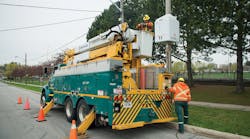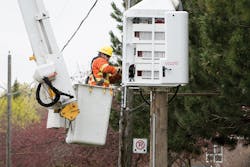To balance power demand and improve the reliability of the power grid, utilities throughout North America are investing in energy storage, which allows energy to be stored during low-peak hours and deployed during times of high demand. As such, the electricity from the storage system can offset the need for additional generation during high-peak times, such as hot summer days.
While many utilities are constructing energy storage facilities on the ground, Toronto Hydro took an entirely different approach. The utility recently launched a prototype program to install a grid-scale, pole-mounted energy storage system.
The project got off the ground in August 2016 with support from the Smart Grid Fund from Ontario’s Ministry of Energy. The funding helps those entities on the leading edge of the smart grid industry to test their grid modernization solutions in real-world settings.
The new energy storage system was developed by Ryerson University’s Centre for Urban Energy (Toronto, Ontario, Canada) and uses eCAMION technology. It consists of a single unit that is capable of storing the equivalent of 2100 smartphone batteries. When paired with a 50-kW transformer, it can power approximately 12 homes.
Reducing Transformer Loads
Toronto Hydro is continuously searching for innovative solutions for current and emerging grid issues. In Ontario, gas-fired plants produce more greenhouse-gas emissions than nuclear or hydro power. Energy storage, however, can reduce the need for gas-fired plants to be engaged during peak demand times, making it an attractive option for the Ontario-based utility.
By deploying the new technology, Toronto Hydro is exploring how to extend the lifespan of some of its equipment through energy storage. As a result, it will help to defer asset replacement and reduce costs on the updating of infrastructure.
For example, a transformer can experience increased load during peak hours, and the increased load, if consistent, can impact the useful life of the transformer. The unit, however, stores energy during off-peak hours and then can release energy to homes during high-peak load hours, serving as an additional source of energy. This can reduce the load on the transformer to an average load, and if the load is reduced, it will ultimately reduce the burden on the transformer.
So far, the energy storage system has shown the ability to reduce strain on the local transformer, which Toronto Hydro considers a positive result. By reducing strain, it can help extend the life of the equipment.
In addition, the system can act as a source of backup power during an outage. If a power outage is detected on the street where the system is located, the energy storage system can provide a temporary source of electricity to the small amount of homes connected to the transformer. The duration of temporary power available can vary, but it’s possible that for short-term outages, Toronto Hydro’s customers won’t experience any interruption in service.
Testing Out the Units
Before installing this new technology on a wide scale, the project is focused on testing. Toronto Hydro is playing a key role in this phase by providing access to its large-scale electrical grid, which allows the technology to be tested in real-world situations.
Because a grid-scale pole-mounted unit has never been attempted before, Toronto Hydro has to ensure that it can perform in all types of scenarios. This new technology is unique because it uses existing infrastructure — electrical poles — and does not have a footprint. In a large city such as Toronto, this is a key component of success, as energy storage projects traditionally use large batteries that can be the size of shipping containers. Finding space for these batteries in a crowded city can be a challenge. The new storage units’ compact size and ability to be mounted on existing infrastructure, such as poles, makes it possible to install them throughout the city.
Installing the System
Toronto Hydro’s line crews typically spend a maximum of eight hours to install the pole-mounted energy storage unit. The work method is similar to installing other pole-mounted assets like pole-mounted transformers.
When installing the unit, the linemen followed the utility’s well-established process, which directs how new assets being introduced into the system are managed as far as health and safety and training. This includes the establishment of training material and the required training sessions and work processes for employees who will work and interact with these new assets.
Toronto Hydro has started with one unit, but if the pilot continues to demonstrate positive results, the utility may expand the project to other areas of the city. Overall, the utility has the potential to install units on all of its nearly 175,000 poles. Like any new technology, the full deployment could go slowly and take time, but the opportunity is there, and the utility plans to take advantage of it for the benefit of its customers. ♦
Gary Thompson is the supervisor of engineering in generation and capacity planning for Toronto Hydro. An engineer with more than 30 years of experience, he is an honorary fellow/ lecturer at the Centre for Urban Energy at Ryerson University, and a member of the boards of Energy Storage Canada and the Canadian Solar Industry Association.




